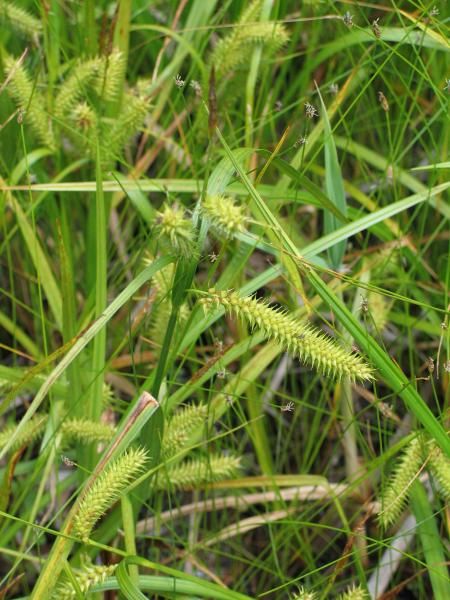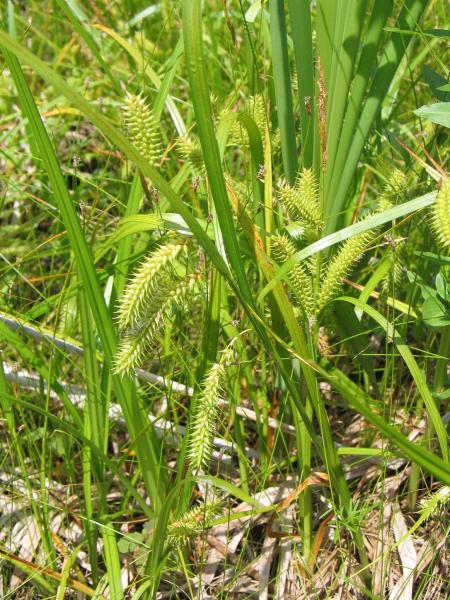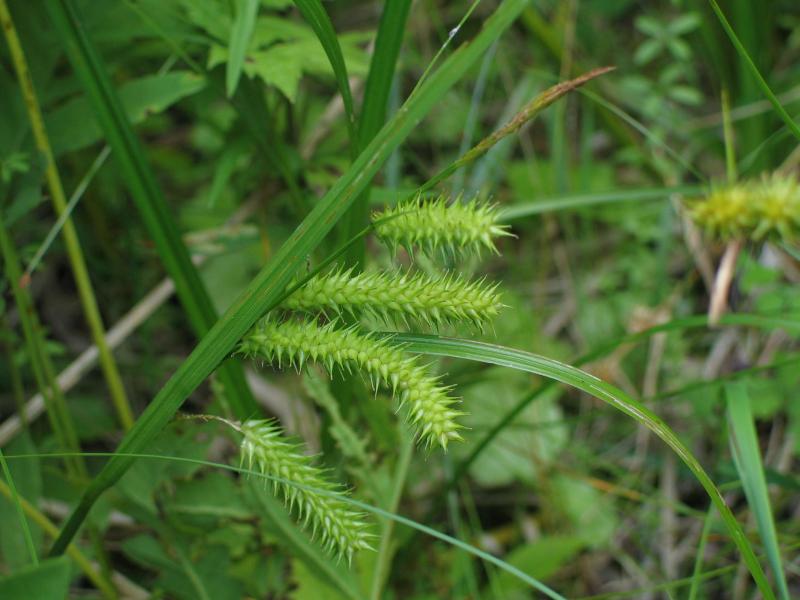Schweinitz's Sedge
Carex schweinitzii Dewey ex Schwein.
- Class
- Monocotyledoneae (Monocots)
- Family
- Cyperaceae (Sedge Family)
- State Protection
- Threatened
Listed as Threatened by New York State: likely to become Endangered in the foreseeable future. For animals, taking, importation, transportation, or possession is prohibited, except under license or permit. For plants, removal or damage without the consent of the landowner is prohibited.
- Federal Protection
- Not Listed
- State Conservation Status Rank
- S2S3
Imperiled or Vulnerable in New York - Very vulnerable, or vulnerable, to disappearing from New York, due to rarity or other factors; typically 6 to 80 populations or locations in New York, few individuals, restricted range, few remaining acres (or miles of stream), and/or recent and widespread declines. More information is needed to assign either S2 or S3.
- Global Conservation Status Rank
- G3G4
Vulnerable globally, or Apparently Secure - At moderate risk of extinction, with relatively few populations or locations in the world, few individuals, and/or restricted range; or uncommon but not rare globally; may be rare in some parts of its range; possibly some cause for long-term concern due to declines or other factors. More information is needed to assign either G3 or G4.
Summary
Did you know?
The specific epithet schweinitzii was named in honor of Lewis David de Schweinitz (1780-1834) who among other subjects studied the genus Carex.
State Ranking Justification
There are seventeen known populations and nearly 50 historical locations. Some of these historical locations could not be relocated after multiple survey attempts; however, new populations have been found elsewhere. This plant prefers calcareous seeps, a habitat type with a very limited range. New York has a large number populations compared to other states, so it carries a higher responsibility in ensuring this species' long-term survival. Michigan and Ontario also appear to have a large number of populations.
Short-term Trends
About twenty populations have been seen within the past 20 years. Most of these appear to be stable. There are also many (up to about 50) additional populations which are known only from historical records. Overall, short term trends are not definitive but appear to indicate that Carex schweinitzii is currently stable in New York.
Long-term Trends
Three populations are considered extirpated. Numerous populations (about 50) have not been seen in over 20 years. Some of these historical populations have been searched for numerous times without successfully relocating the populations. Still, the locality information for these historical populations is mostly not precise and these populations may still be extant. Other historical populations have not been searched for and it is also unknown if these populations are still extant. Some new populations have been found in recent years. Many of these "new" populations may have been overlooked in the past. Other extant populations have been known for decades but exact trends are unclear. At least some of these populations are large and robust and may be stable. Overall, it appear that the long-term trends indicate at least a small decline in New York.
Conservation and Management
Threats
Most of the extant populations are not currently threatened. Some are potentially threatened by mowing, residential development, road maintenance, succession of habitat, and changes in hydrology.
Conservation Strategies and Management Practices
Many populations occur on unprotected land that is fragile. These areas should be protected with agreements with the landowners or purchased by conservation organizations. Road work and clearing for utility corridors should be done with consideration of avoiding negatively impacting populations and the hydrology of habitats where populations occur.
Research Needs
Survey work to historical populations is needed to assess whether these populations are still extant. Some populations occur in utility corridors that are kept open by various management practices. Research should be conducted on how populations respond to these management actions.
Habitat
Habitat
Carex schweinitzii grows in strongly calcareous, perennially wet, seepy habitats often in association with rich fens. It is commonly found on edges of fens. It also occurs in calcareous marshes, swamps, and shores. It does particularly well in and on the margins of rivulets and small drainage channels that have strongly calcareous water. This includes perennially wet roadside ditches which act as drainage channels. It does well in full sun but also occurs in more shaded environments. Adjacent vegetation is often low and moss cover is usually high although it can occur with taller species such as Typha latiflolia. It frequently occurs in dense patches sometimes to the exclusion of other plants (New York Natural Heritage Program 2006). Shallow cold streams, springheads, seeps, margins of fens, and seepy stream, pond, and lakeshores in open or lightly shaded sites, in highly calcareous soils (Reznicek and Ford 2002). Cool shady streambanks (Gleason and Cronquist 1991). A species of wet ground along cold spring-fed rivers and brooks, in mixed or coniferous cover (Voss 1972). Calcareous swamps, meadows and low woods (Fernald 1970).
Associated Ecological Communities
- Inland calcareous lake shore*
(guide)
The gravelly, sandy, or muddy shore of an inland lake or pond with calcareous water and seasonally fluctuating water levels. There may be few plants and those that are present are usually herbaceous.
- Northern white cedar swamp
(guide)
A swamp that occurs on organic soils in cool, poorly drained depressions in central and northern New York, and along lakes and streams in the northern half of the state. These swamps are often spring-fed with continually saturated soils. Soils are often rich in calcium. The characteristic tree is northern white cedar, which makes up more than 30% of the canopy cover.
- Red maple-tamarack peat swamp
(guide)
A swamp that occurs on organic soils (peat or muck) in poorly drained depressions. These swamps are often spring fed or enriched by seepage of mineral-rich groundwater resulting in a stable water table and continually saturated soil. The dominant trees are red maple and tamarack. These species usually form an open canopy (50 to 70% cover) with numerous small openings dominated by shrubs or sedges.
- Rich graminoid fen
(guide)
A wetland of mostly grasses usually fed by water from highly calcareous springs or seepage. These waters have high concentrations of minerals and high pH values, generally from 6.0 to 7.8. Plant remains do not decompose rapidly and these grasses usually grow on older, undecomposed plant parts.
- Rich hemlock-hardwood peat swamp
(guide)
A swamp that occurs in central New York in depressions or concave slopes which receive groundwater discharge. These swamps usually have a fairly open canopy (50 to 70% cover), scattered shrubs, and a diverse groundlayer with sedges, mosses, and forbs. The characteristic canopy trees are eastern hemlock (which usually have at least 20% cover), red maple, yellow birch, black ash, tamarack, white pine, smooth serviceberry, balsam fir, and northern white cedar.
- Rich shrub fen
(guide)
A wetland with many shrubs that is usually fed by water from springs and seeps. These waters have high concentrations of minerals and high pH values, generally from 6.0 to 7.8. Plant remains in these fens do not decompose rapidly and thus the plants in these fens usually grow on older, undecomposed woody plant parts.
- Rich sloping fen
(guide)
A small, gently sloping wetland that occurs in a shallow depression on a slope composed of calcareous glacial deposits. Sloping fens are fed by small springs or groundwater seepage. Like other rich fens, their water sources have high concentrations of minerals and high pH values, generally from 6.0 to 7.8. They often have water flowing at the surface in small channels or rivulets.
- Sedge meadow
(guide)
A wet meadow community that has organic soils (muck or fibrous peat). Soils are permanently saturated and seasonally flooded. The dominant herbs must be members of the sedge family, typically of the genus Carex.
- Shallow emergent marsh
(guide)
A marsh meadow community that occurs on soils that are permanently saturated and seasonally flooded. This marsh is better drained than a deep emergent marsh; water depths may range from 6 in to 3.3 ft (15 cm to 1 m) during flood stages, but the water level usually drops by mid to late summer and the soil is exposed during an average year.
* probable association but not confirmed.
Associated Species
- Calliergon giganteum
- Campylium stellatum
- Carex bebbii (Bebb's sedge)
- Carex flava (yellow sedge)
- Carex hystericina (porcupine sedge)
- Carex interior (inland sedge)
- Carex leptalea (bristle-stalked sedge)
- Cypripedium reginae (showy lady's-slipper)
- Eriophorum viridicarinatum (green-keeled cotton-grass)
- Liparis loeselii (Loesel's twayblade)
- Packera aurea (golden ragwort)
- Parnassia glauca (common grass-of-Parnassus)
- Platanthera dilatata
- Rhamnus alnifolia (alder-leaved buckthorn)
- Selaginella apoda (meadow spikemoss)
- Spiranthes lucida (shining ladies'-tresses)
- Thelypteris palustris
- Thuja occidentalis (northern white cedar, arbor vitae)
Range
New York State Distribution
Carex schweinitzii is found throughout most of the state although it is absent from the Adirondacks. It is mostly found widely scattered in disjunct, isolated populations. In parts of central New York it very abundant with numerous populations.
Global Distribution
Carex schweinitzii is uncommon throughout most of its range but can form large colonies where it is found. It occurs from Connecticut and Vermont west to New York, Ontario, Michigan, and Wisconsin south to Virginia (Reznicek and Ford 2002).
Identification Comments
General Description
Schweinitz' sedge is a grass-like perennial that occurs in patches. Its leaves are 4-11 mm wide and often occur in small tufts, sometimes without flowering stems. When present, flowering/fruiting stems 18-65 cm long arise from the leaves at the bases of the plants and are terminated by a narrowly cylindrical cluster (spike) of male flowers. Secondary stems branch off of the main stems in the upper part of the plants and are terminated by narrowly cylindrical spikes of female flowers/fruits. Fruits (perigynia) are 4.2-7.0 mm long.
Identifying Characteristics
Carex schweinitzii is a long rhizomatous colonial perennial. Leaves are 4-11 mm wide and reproductive culms are 18-65 cm long. There are 2-4 lateral pistillate spikes. Pistillate spikes have perigynia mostly densely arranged. The proximal part of the pistillate spikes gradually taper to the subtending peduncle and have perigynia less densely arranged. The lowest pistillate spike can be erect but more often and with age, is spreading to recurved. The terminal spike is staminate. Staminate scales are acute to acuminate and smooth except at the tip. Perigynia are 7-11 veined, 4.2-7.0 mm long, and taper to a bidentate beak (Reznicek and Ford 2002, New York Natural Heritage Program 2006).
Best Life Stage for Proper Identification
The easist time to identify C. schweinitzii is when perigynia are just immature to mature but are not yet shedding.
Similar Species
Carex schweinitzii is a very distinctive plant especially in the field although the inflorescences some what resemble C. lurida, C. baileyi, and C. hystericina. The colonial habit and often spreading to recurved proximal pistillate spikes which taper at their bases, are good field characteristics (New York Natural Heritage Program 2006). Other characters that separate C. schweinitzii include: elongate rhizomes; plants not cespitose; staminate scales acute to acuminate and smooth margined except at tip; and perigynia 7-11 veined. Carex lurida, C. baileyi, and C. hystericina have short rhizomes; are densely cespitose; and staminate scales have scabrous awns. C. hystericina also has perigynia with 13-21 veins (Reznicek and Ford 2002).
Best Time to See
Carex schweinitzii starts to fruit in the very end of May and sometimes the fruits can persist as late as August. In the early part of this season the fruits are quite immature and late in the season they are shedding readily. Therefore, the best time to survey for this species is from about mid June till mid July.
- Fruiting
The time of year you would expect to find Schweinitz's Sedge fruiting in New York.
Schweinitz's Sedge Images
Taxonomy
Schweinitz's Sedge
Carex schweinitzii Dewey ex Schwein.
- Kingdom Plantae
- Phylum Anthophyta
- Class Monocotyledoneae
(Monocots)
- Order Cyperales
- Family Cyperaceae (Sedge Family)
- Order Cyperales
- Class Monocotyledoneae
(Monocots)
- Phylum Anthophyta
Additional Common Names
- Sedge
Comments on the Classification
Carex schweinitzii has a simple taxonomic history and is a very distinct species. It is in section Vesicariae (Reznicek and Ford 2002).
Additional Resources
Best Identification Reference
Reznicek, A.A. and B.A. Ford. 2002. Carex Linnaeus sect. Vesicariae (Heuffel) J. Carey. Pages 501-511 in Flora of North America Editorial Committee (editors), Flora of North America, North of Mexico, Volume 23, Magnoliophyta: Commelinidae (in part): Cyperaceae. Oxford University Press, New York, NY, USA. 608pp + xxiv.
Other References
Fernald, M.L. 1950. Gray's manual of botany. 8th edition. D. Van Nostrand, New York. 1632 pp.
Gleason, Henry A. and A. Cronquist. 1991. Manual of Vascular Plants of Northeastern United States and Adjacent Canada. The New York Botanical Garden, Bronx, New York. 910 pp.
Holmgren, Noel. 1998. The Illustrated Companion to Gleason and Cronquist's Manual. Illustrations of the Vascular Plants of Northeastern United States and Adjacent Canada. The New York Botanical Garden, Bronx, New York.
New York Natural Heritage Program. 2010. Biotics database. New York Natural Heritage Program. New York State Department of Environmental Conservation. Albany, NY.
New York Natural Heritage Program. 2024. New York Natural Heritage Program Databases. Albany, NY.
Reschke, Carol. 1990. Ecological communities of New York State. New York Natural Heritage Program, New York State Department of Environmental Conservation. Latham, NY. 96 pp. plus xi.
Voss, E.G. 1972. Michigan Flora, Part I. Gymnosperms and Monocots. Cranbrook Institute of Science Bulletin 55 and the University of Michigan Herbarium. Ann Arbor. 488 pp.
Weldy, T. and D. Werier. 2010. New York flora atlas. [S.M. Landry, K.N. Campbell, and L.D. Mabe (original application development), Florida Center for Community Design and Research http://www.fccdr.usf.edu/. University of South Florida http://www.usf.edu/]. New York Flora Association http://newyork.plantatlas.usf.edu/, Albany, New York
Links
About This Guide
Information for this guide was last updated on: May 31, 2006
Please cite this page as:
New York Natural Heritage Program. 2024.
Online Conservation Guide for
Carex schweinitzii.
Available from: https://guides.nynhp.org/schweinitzs-sedge/.
Accessed April 16, 2024.




